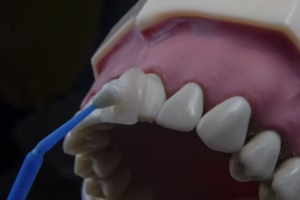Table of Contents
ToggleDental implants are a modern, reliable solution for replacing missing or damaged teeth, offering a natural-looking and permanent alternative to dentures or bridges.
Whether you’re dealing with tooth loss due to injury, decay, or age, dental implants provide a long-lasting and effective way to restore your smile.
In this guide, we’ll explore what dental implants are, the different types available, the benefits they offer, and the procedure involved in getting them.
If you’re considering dental implants, this guide is designed to help you make an informed decision.
What Are Dental Implants?
Dental implants are titanium posts or frames that are surgically placed into the jawbone beneath your gums. Once the implants are secured in place, replacement teeth or bridges are mounted on them.
The titanium material integrates with the jawbone over time, mimicking the function of natural tooth roots. This fusion process, known as osseointegration, ensures that the dental implant is stable and secure, providing a reliable foundation for the restoration of your smile.
Unlike traditional dentures or bridges, which rest on the gums, dental implants act as a permanent solution that integrates with your bone structure, making them more durable and comfortable.
Types of Dental Implants
When it comes to dental implants, there are several types, each suited for different needs and dental conditions. The most common types of dental implants include:
1. Endosteal Implants (Root Dental Implants)
Endosteal implants, also known as root dental implants, are the most commonly used type of dental implants.
These implants are surgically placed directly into the jawbone and are designed to replace a single missing tooth, multiple teeth, or even an entire row of teeth.
The implant is made of titanium and is shaped like a screw, which provides a stable foundation for the artificial teeth that will be placed later.
Root dental implants are highly effective because they mimic the function of natural tooth roots, promoting bone growth and ensuring the overall stability of the jawbone.
These implants are ideal for patients who have sufficient bone density in their jaw.
2. Subperiosteal Implants
Subperiosteal implants are a less common type of dental implants that are placed on top of the jawbone, beneath the gum tissue.
These implants are used for patients who do not have enough bone height for traditional root dental implants or those who cannot undergo bone grafting.
A custom metal frame is fitted onto the jawbone, and the posts protrude through the gum line to hold the replacement teeth.
Although subperiosteal implants are less common today, they may still be a viable option for patients with insufficient bone density who are not candidates for other types of implants.
3. Zygomatic Implants
Zygomatic implants are typically used for patients who have experienced severe bone loss in their upper jaw.
Unlike traditional dental implants, which are anchored into the jawbone, zygomatic implants are anchored in the cheekbone (zygomatic bone).
This type of implant is more complex and is generally considered when other options are not feasible.
Zygomatic implants provide a solution for individuals who have suffered significant bone loss but still wish to avoid bone grafting procedures.
Benefits of Dental Implants
Dental implants offer a variety of benefits that make them an attractive solution for those with missing or damaged teeth. Some of the most significant benefits include:
1. Permanent Solution
- Dental implants provide a permanent solution for tooth replacement. Unlike dentures or bridges, which may need to be replaced or adjusted over time, dental implants are designed to last a lifetime with proper care.
- Once the implant has integrated with the bone, it becomes a permanent part of your mouth, providing stability and durability.
2. Improved Appearance
- Dental implants look and feel like natural teeth. Since they are anchored into the jawbone, they mimic the natural structure of your teeth, providing a seamless appearance.
- This can significantly improve your smile and boost your confidence.
3. Enhanced Comfort
- Dental implants are designed to fit securely and comfortably, eliminating the discomfort that often comes with dentures.
- Unlike dentures that can slip or cause irritation, dental implants become a permanent part of your mouth, providing a secure and comfortable solution for tooth replacement.
4. Better Functionality
- Dental implants function like natural teeth, allowing you to eat, speak, and smile with confidence.
- Because they are anchored securely in your jawbone, dental implants provide the same level of functionality as your original teeth, making them a great option for individuals with active lifestyles.
5. Prevention of Bone Loss
- When a tooth is lost, the jawbone underneath it begins to deteriorate over time due to lack of stimulation.
- Dental implants help prevent bone loss by stimulating the jawbone, much like natural tooth roots.
- This process helps maintain the structure of your jaw and prevents further bone deterioration.
The Procedure for Getting Dental Implants
The process of getting dental implants typically involves several steps, including consultations, surgery, and a healing period. Here’s a general overview of the procedure:
1. Consultation and Planning
The first step in getting dental implants is to schedule a consultation with your dentist or oral surgeon.
During this visit, your dentist will evaluate your oral health, take X-rays or CT scans of your jaw, and discuss your goals for the procedure.
They will determine whether you’re a good candidate for dental implants based on factors such as your bone density and overall health.
2. Surgical Placement of the Implant
Once you’re deemed a suitable candidate, the next step is the surgical placement of the dental implant.
This is usually done under local anesthesia, and the implant is inserted into the jawbone. The healing process typically takes several months, during which the implant fuses with the bone.
3. Placement of the Abutment and Restoration
Once the implant has integrated with the jawbone, your dentist will place an abutment—a small connector piece—on top of the implant.
After the abutment is placed, a custom-made crown, bridge, or denture is created to fit your mouth and placed on the abutment, completing the restoration.
Conclusion
Dental implants are an effective and permanent solution for replacing missing teeth. With their natural appearance, durability, and ability to prevent bone loss, they offer numerous benefits over traditional tooth replacement methods.
Whether you’re considering root dental implants or other types of dental implants, it’s important to consult with a qualified dentist to determine the best option for your specific needs.If you’re ready to restore your smile and enjoy the many benefits of dental implants, reach out to Perfect Smile today. Our expert team is here to help guide you through the process, ensuring that you receive the highest quality care and achieve the smile you deserve.






